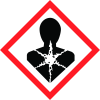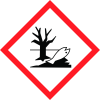B-010N-5MG
AccuStandard, Inc
Revision date : 2014-12-02



Note: Ingredients listed on restricted chemical lists
General Information
Revision date
2014-12-02
Product name
B-010N-5MG
CAS No.
59080-32-9
Supplier name
AccuStandard, Inc
Emergency telephone
1-203-786-5290
Icons in SDS
Company Information
Company name
AccuStandard, Inc
E-mail address of the competent person responsible for the Safety Data Sheet
edocs@accustandard.com
GHS Information
Signal word
Danger
Hazard Codes
Hazard statements (CLP)
H302, H335, H350, H401, H413
Hazard statements
Code
Statements
H302
Harmful if swallowed
H335
May cause respiratory irritation
H350
May cause cancer
H401
Toxic to aquatic life
H413
May cause long lasting harmful effects to aquatic life
Precautionary statements
Code
Statements
P202
Do not handle until all safety precautions have been read and understood.
P262
Do not get in eyes, on skin, or on clothing.
P264
Wash ... thoroughly after handling.
P280
Wear protective gloves/protective clothing/eye protection/face protection.
P284
[In case of inadequate ventilation] Wear respiratory protection.
P310
Immediately call a POISON CENTER or doctor/physician.
P338
Remove contact lenses, if present and easy to do. Continue rinsing.
P360
Rinse immediately contaminated clothing and skin with plenty of water before removing clothes.
P404
Store in a closed container.
Section 2
SECTION 2: Hazards identification
2.2 Label elements
0 * 2 HEALTH 2 0 FLAMMABILITY 0 - continued P264 - Wash thoroughly after handling. Do not take internally. Eye wash and safety equipment should be readily available. P280 - Protective gloves must be worn to prevent skin contact. P284 - Respiratory Protection: If workplace exposure limit(s) of product or any component is exceeded (see TLV/PEL), a NIOSH/MSHA approved air supplied respirator is advised in absence of proper environmental control.
Hazard statements
H302 - Harmful if swallowed. (Acute toxicity, oral, category 4) H335 - May be irritating to mucous membrane and upper respiratory system. (Specific target organ toxicity, single exposure; Respiratory tract irritation, category 4) H350 - Possible cancer hazard. (Carcinogenicity, category 1B) H350 - This product is or contains a component that is classified (ACGIH, IARC, NTP, OSHA) as a possible cancer hazard. (Carcinogenicity, category 1B) H401 - Toxic to fish and other water organisms. H413 - May cause long-term adverse effects in the aquatic environment. Precautionary Codes: P202 - This product should only by used by persons trained in the safe handling of hazardous chemicals. P262 - Do not get in eyes, on skin or clothing. - continued
2.3 Other hazards
2.2.1 - Symptom of Exposure Health/Environment
Environmental hazards
Toxic to fish and other water organisms. (H401) May cause long-term adverse effects in the aquatic environment. (H413) Bioaccumulation of this chemical may occur. It is strongly advised that this substance does not enter the environment. Possible cancer hazard. (Carcinogenicity, category 1B)
Potential health effects
May be irritating to eyes. May be irritating to skin. May be harmful if absorbed through the skin. (Acute toxicity, dermal, category 5) May be irritating to mucous membrane and upper respiratory system. (Specific target organ toxicity, single exposure; Respiratory tract irritation, category 4) May be harmful if inhaled. (Acute toxicity, inhalation, category 5) Harmful if swallowed. (Acute toxicity, oral, category 4) 2.2.3 - Routes of Entry Inhalation, ingestion or skin contact. 2.2.4 - Carcinogenicity

